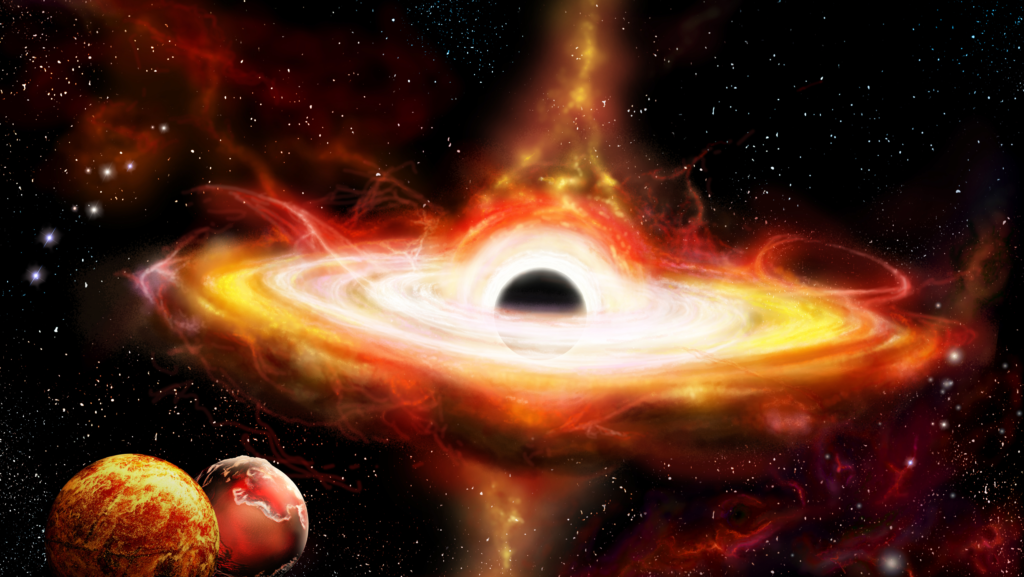Today we’ll discuss about Orion Nebula and also Orion Stars. But I’ll tell you today how Orion Nebula link Orion Star. So, May be Orion Nebula is Orion Stars.
Our sun was formed 4.5 Billion years ago. But have you ever thought where was our formed. The formation of our sun is a very old tale and to trace where it was formed is not possible. But we can find such place in our galaxy where nowadays our sun type stars are forming. One such place is ‘Orion nebula or Orion Stars’. This is the most beautiful object of the winter sky.
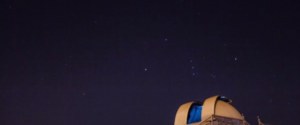


Orion Stars
In a sense, this is a nursery of stars where youngsters, infacts and toddlers are present. Orion nebula is 1500 light-years away from us. There are a thousand stars in it which are forming and are at different stages. Its width is 20 light-years. Now these are a lot of stars within 20 light years. If you compare to the star nearest to our sun it is Centauri system and it is 4 light year away.
In Orion, there are a 1000 stars within only 20 light years. Most of the colours which give beauty to Orion are 4 stars which at this time are present in it. They are much bigger stars than our sun but they are young.
These stars astronomers call ‘Trapezium’ because these are 4 stars in it. When you talk about the beauty of the Orion Stars or Orion Nebula you immediately see its red color. This red color is because of hydrogen gas and this hydrogen gas is being lighted up with the light of Trapezium stars (the big stars).
Orion Stars Transition of electron
Likewise, you see a light green tinge in Orion and the green light tells us oxygen atoms are present in the Orion Stars or Orion nebula and this is a specific type of transition of atoms or electron which produce this green color.

The Orion Nebula you are seeing now is in visible light and a lot of dust and gases are obscured or absorbed in visible light. If you want to see what is behind that light for that you have to see it in infrared light and then you start seeing other structures of this nebula also.
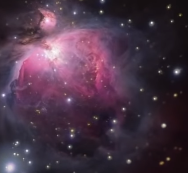
This is the sharpest image taken by the Hubble Space telescope but when see it infrared you realise its width is much more and this image of ‘Spitzer’ space telescope.
Now let’s dive into the Orion Stars or Orion Nebula.

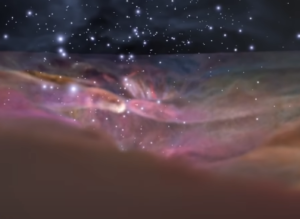
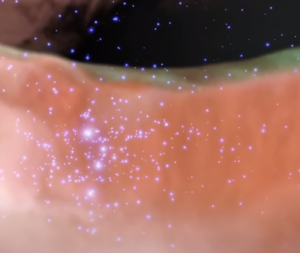
This is a combination image not a computer simulation rather astronomers have combined visible and infrared lights to know what you see if you go into the nebula. This first thing is you are seeing a sort of canyon in which some area is empty.
The empty space is because the radiation of new stars (Trapezium) has evaporated some gases. And here new star not only trapezium, other stars can also be seen here. Not only stars you start seeing light images of bow shocks and with them young stars (the disk of the star is visible).
This type of disks have been discovered by astronomers in the nebula, not one but several dozen. These young stars are called Protoplanetary disks or “PROPLYDS”.
Come let’s go again into the Orion Stars or Orion Nebula and now we are in visible light.
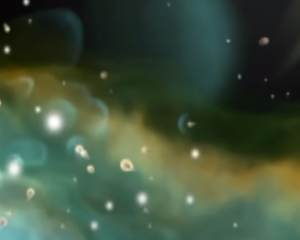
We are seeing some tadpole type things. These are ‘Proplyds’ and if you see what is happening in any one of the proplyds you will see the making of a stars in that.

Now you see there is star in the middle and jets are streaming out of it and planets will eventually form from the dusky disk which is alongside and our sun was formed from this type of proplyd.

Hubble Space Telescope has identified several dozen proplyds in the Orion Stars or Orion Nebula. Now the Question is why are these proplyds shaping up like a tadpole. The Actual reason is the radiation of the big stars (Trapezium) which made the cavity of Nebula by evaporating gas and dust are also evaporating these proplyds.

This is a computer simulation which tells you that this is a proplyd abd inside it, there is a sun type star and there is a dust disk around it. This disk is from which eventually planets will form after some times.
Our Solar System at one time was inside this proplyd type thing and from there planets were formed out of which Mercury Venus Earth Mars, all of them eventually became a part of your solar system.
In a way, this is an interesting tension that in the nebula the radiation (if excess) of the stars formed initially (the big stars like trapezium) can stop the formation of some stars. But most of the stars are in thus dusty shell, they clear out the dust and eventually come out like our solar system.
Our Own Solar System
Our Sun probably was formed in this type of nebula 4.5 Billion years ago and may be these processes are responsible for the making of our own solar system. Our sun was not alone in this nebula rather several other star were formed with it. But today its brothers and sisters have spread out in our galaxy and we do not know where are they and which ones.
The age of big stars is less so the big stars must be finished by now but those having a mass like our sun or whose mass is less than our sun are still present in our galaxy and probably there is a solar system also present with almost every star.
So may be, on some solar system from among the solar system of the nearby brothers and sisters of our sun, life is present, asking the question where was their star formed and where the brothers and sisters of their star.
